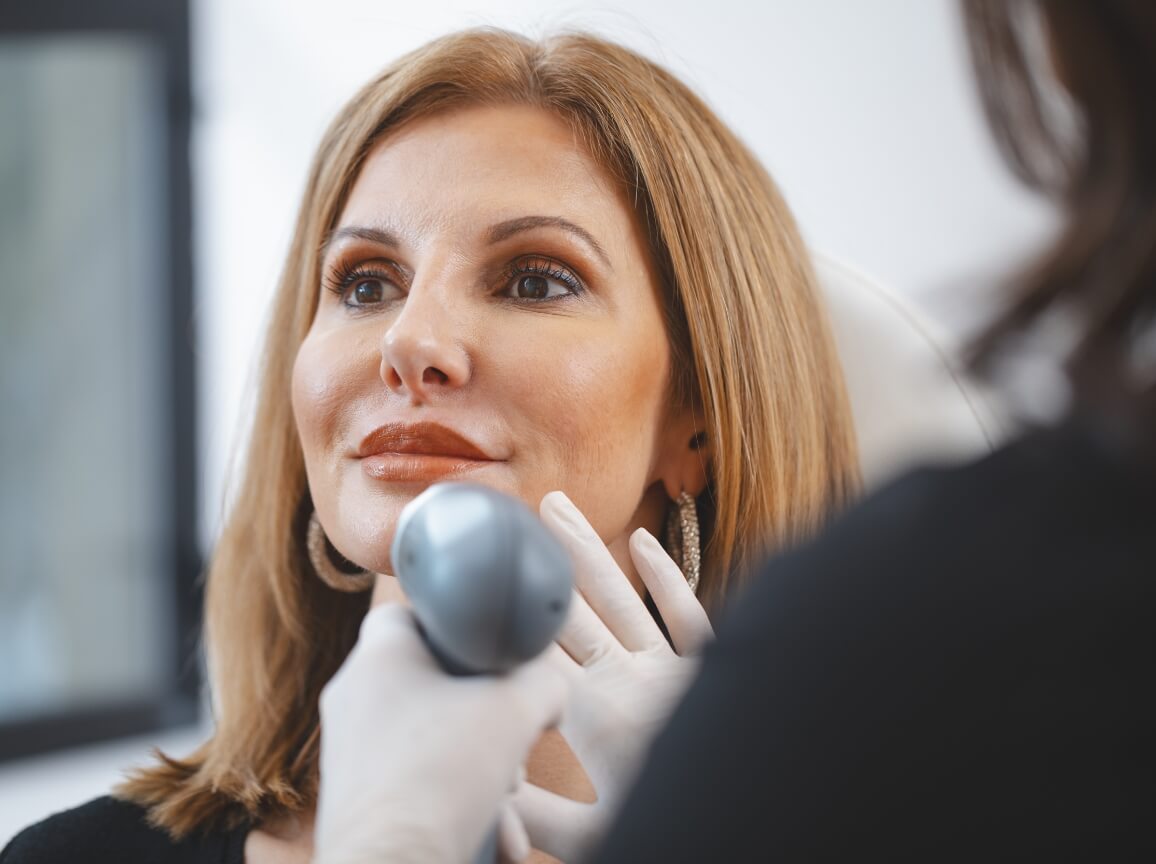Neck Lift In Grass Valley, CA
 Model
Model
As people age, the effects of gravity, sun exposure, and daily life stresses can be seen on their faces. The jawline can grow slack and jowly while folds and fat deposits appear around the neck.
Table Of Contents
- Intro
- What Is a Neck Lift?
- What Are the Benefits of a Neck Lift?
- Am I a Candidate for a Neck Lift?
- Combining Your Neck Lift with Other Procedures
- How Is a Neck Lift Performed?
- What Is Neck Lift Recovery Like?
- When Will I See My Neck Lift Results?
- How Much Does a Neck Lift Cost in Grass Valley, CA?
- What Our Patients Are Saying
 Model
Model
Neck lift surgery can correct visible signs of aging by tightening underlying muscles and redraping the skin of your neck. It can also dramatically improve neck and chin definition by removing excess fat, whether age-related or genetic. It can be done alone or with other procedures, such as a forehead lift, eyelid surgery, or nose reshaping.
What Is a Neck Lift?
A neck lift, or lower rhytidectomy, is a cosmetic procedure designed to improve neck contour. This procedure is ideal for patients with visible signs of aging in the neck, such as sagging skin and muscle and/or excessive fat that cannot be adequately addressed with liposuction or other procedures. This procedure focuses on tightening the skin and underlying tissues and sculpting the neck fat if needed to achieve a more angular, youthful, and aesthetically pleasing appearance.
Learn More About Dr. LattyakWhat Are the Benefits of a Neck Lift?
A neck lift is a specialized procedure that primarily deals with aging concerns in the neck. This procedure can tighten the underlying tissues and muscles of the neck for a smooth result, as well as correct fat pockets and sagging skin for a sculpted appearance. This procedure can also address neck banding and wrinkles for a contoured profile.
Am I a Candidate for a Neck Lift?
The best candidates for a neck lift have moderate to severe sagging of neck skin and/or significant fat deposits in the neck but also have well-defined bone structures. Patients with substantial sagging of the face skin and jowls, in addition to the neck, may be better off with a facelift, which addresses both the lower two-thirds of the face and the neck together. Most patients are in their forties to sixties, but neck lifts can also be done successfully on people in their seventies or eighties.
Neck lift candidates:
- Are generally in good health
- Do not smoke or are willing to quit
- Have sagging skin and/or excessive fat around the neck and jawline
- Have neck banding
- Have relatively good skin elasticity
- Have realistic expectations of results
Candidates may also be patients who have already had a facelift and, therefore, do not need additional treatment of the upper-to-mid face.
What Are My Neck Lift Options?
In addition to the traditional neck lift, Dr. Lattyak offers a few other neck lift options for patients with alternative goals and needs.
Direct Neck Lift
A direct neck lift, or anterior (front) neck lift, is a focused treatment of localized loose skin and pockets of fat in the front of the neck (“turkey gobbler” neck). While less invasive than other methods, this procedure is typically more suitable for older patients who wish to correct a “turkey gobbler” neck appearance, prefer to avoid general anesthesia, and are accepting of a more visible scar than with a traditional neck lift.” Although this is a less invasive procedure and is usually done in the office setting, when performed on the appropriately selected patient, it dramatically improves neck contour.
Liposuction of the Neck
In some cases, liposuction is adequate for treating the neck. Neck liposuction is generally ideal for young patients with good skin quality/tightness and whose only focus is mild to moderate fat excess under the chin or in the front of the neck.
Combining Your Neck Lift with Other Procedures
Many patients benefit from combining their neck lift procedures with other facial enhancement surgeries to achieve facial harmony and cohesive rejuvenation. By combining your neck lift with another procedure, you can see a more comprehensive improvement in your facial aging for a natural-looking result. Some popular combination procedures include:
 Model
Model
Facelift
If you are experiencing advanced facial aging throughout the neck and the mid-face, a facelift is typically a better choice than a neck lift alone. A facelift involves lifting the cheeks, jowls, and jawline in addition to lifting the neck, giving you the most cohesive and comprehensive result. Dr. Lattyak typically advises these patients not to have a neck lift alone to avoid the unnatural juxtaposition of a rejuvenated neck next to an uncorrected, aging lower face. During your consultation, Dr. Lattyak will help you choose the most appropriate procedure for you.
 Model
Model
Blepharoplasty
Blepharoplasty, or eyelid surgery, treats sagging skin and pockets of fat around the upper and lower eyelids, creating a more alert, youthful appearance. Patients with severe sagging in the upper eyelids may also experience improved vision if the skin had previously obstructed their field of view.
How Is a Neck Lift Performed?
Your Consultation
Neck lifts are very individualized procedures. In your initial consultation, Dr. Lattyak will evaluate your neck, including the skin and underlying tissues and muscles, and discuss your goals for the surgery.
Dr. Lattyak will check for medical conditions that could cause problems during or after surgery, such as uncontrolled high blood pressure, blood clotting problems, or the tendency to form excessive scars. Be sure to tell Dr. Lattyak if you smoke or are taking any drugs or medications, especially aspirin or other medicines that affect clotting.
If you decide to have a neck lift, Dr. Lattyak will explain the techniques and anesthesia he will use, the type of facility where the surgery will be performed, and the risks and costs involved. Don’t hesitate to ask Dr. Lattyak any questions you may have, especially those regarding your expectations and concerns about the results.
To prepare for your neck lift consultation, have a strong sense of your specific goals and concerns so that you can make the most of your meeting with Dr. Lattyak. He will be honest with you about what you can expect from the procedure’s results and may suggest an alternative based on your goals and level of necessary revision.
If you are interested in a neck lift and want to see if you are a candidate for the procedure, call the Élan Clinic today at (530) 273-3400 to schedule a consultation with Dr. Lattyak.
The Neck Lift Procedure
A neck lift is an outpatient procedure so that you can return home after surgery. Depending on the type of neck lift chosen, the procedure may be performed at the Grass Valley Surgery Center under general anesthesia or in Dr. Lattyak’s office-based facility.
Neck lifts at Dr. Lattyak’s office-based facility are performed under local anesthesia with a sedative to make you drowsy. You’ll be awake but relaxed, and your neck will be insensitive to pain, though you may feel occasional tugging or mild discomfort.
A traditional neck lift usually takes several hours or longer if you have more than one procedure. The incisions usually begin just in front of the lower ear, extend around the earlobe into the crease behind the ear, and continue posteriorly into the scalp. A small incision is also made under the chin.
Dr. Lattyak separates the skin from the fat and muscle below. Fat may be trimmed or suctioned from around the neck and chin to improve the contour. Dr. Lattyak then tightens the underlying muscle and membrane, pulls the skin back, and removes the excess. Stitches secure the layers of tissue and close the incisions; metal clips may be used on the scalp.
After surgery, a small tube may be placed behind your ear to help drain excess fluids. Dr. Lattyak may also place bandages around the treatment area to minimize swelling and bruising. You will be monitored as you recover from anesthesia before you are discharged.
With your family member or caregiver, you will be provided with specific aftercare instructions and cleared to be driven home.
 Model
Model
What Is Neck Lift Recovery Like?
Discomfort is usually manageable after surgery, but if you are uncomfortable, pain medication prescribed by Dr. Lattyak can alleviate it. (Severe or persistent pain or a sudden swelling of your face should be reported to Dr. Lattyak immediately.)
Some numbness and tightness of the skin is quite normal; it should disappear within a few months.
You will be instructed to keep your head elevated and as still as possible for a few days following surgery, as this will help keep the swelling to a minimum and reduce the risk of bleeding. Your drainage tube will be removed a day or two after surgery. Bandages are usually changed the day after surgery and must remain in place for one week. It’s normal for your treatment area to be bruised, puffy, and discolored in the first few weeks after surgery. You are still in the early stages of healing, so your results will not be apparent yet.
Dr. Lattyak only uses dissolvable stitches. The ends of the stitches are usually trimmed one week after surgery.
You should be up and about in a day or two, but plan on taking it easy for the first week after surgery. Be especially gentle with your face and hair since your skin will be tender and numb and may not respond normally at first.
Dr. Lattyak will give more specific guidelines for gradually resuming your normal activities. They’re likely to include these suggestions:
- Avoid strenuous activity, including sex and heavy housework, for at least two weeks
- Walking and mild stretching are fine and even help the healing process by increasing circulation
- Avoid alcohol, steam baths, and saunas for several months
- Above all, get plenty of rest and allow your body to spend its energy on healing
As you heal, your neck and jaw may look and feel odd. Swelling and bruising may be unsightly, and your skin will feel tight. The bruising may persist for two or three weeks, and you may tire easily.
By the third week, you should look and feel much better. Most patients return to work about ten days to two weeks after surgery. If you need it, makeup can mask most of the bruising that remains.
When Will I See My Neck Lift Results?
The chances are excellent that you’ll be happy with your neck lift, especially if you realize that the results may not be immediately apparent. Even after the swelling and bruises are gone, you may still have some residual effects, such as tight, dry skin. Men may find they have to shave in new places on the neck and where areas of beard-growing skin have been repositioned.
You’ll have some scars from your neck lift, but they’re usually hidden by your hair or in the natural creases of your face and ears. In any case, they typically fade within time and should be scarcely visible once they mature.
Having a neck lift doesn’t stop the clock. Your face will continue to age with time, and you may want to repeat the procedure one or more times-perhaps five or ten years down the line. But in another sense, the effects of even one neck lift are lasting; years later, you should continue to look better than if you’d never had a neck lift.
Once fully healed from your neck lift, you can enjoy a more contoured, sculpted profile that highlights your chin and jawline, as well as a smooth neck with minimized wrinkles and reduced sagging skin.
View before & after galleryHow Much Does a Neck Lift Cost in Grass Valley, CA?
The cost of a neck lift in Grass Valley will be uniquely determined by the nature of your surgical plan. Dr. Lattyak creates custom surgical plans to best address the needs and goals of the patient, so it will look a little differently for each person. The cost is also influenced by the type of neck lift, the anesthesia used, where the surgery is performed, and if you have combined procedures.
Once the surgical plan has been developed and agreed upon, Dr. Lattyak will provide an accurate cost estimate.
Schedule A ConsultationLife-changing Results
What Our Patients Are Saying

“I really appreciate the time taken to explain procedures and options by Dr. Lattyak when I came in for multiple procedures stemming from a car accident 10 years ago. Quality work and practically painless!” “I’m a 60 year old teacher, not quite ready to retire. For my end of career time in the classroom I wanted to look more refreshed and youthful. Dr. Lattyak and his staff helped make this dream come true. The results of upper eyelid and brow lift are beautiful and the recovery period was over quickly. Thanks for everything.”
“I am so happy with my experience with Dr. Lattyak, his staff, and my surgery results. I will (and do!) recommend this office to anyone considering surgery.”
“Never had a better treatment. Nurses were great and Dr. Lattyak is remarkable.”

